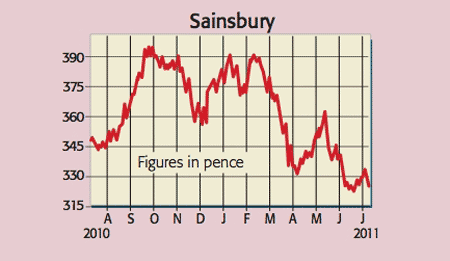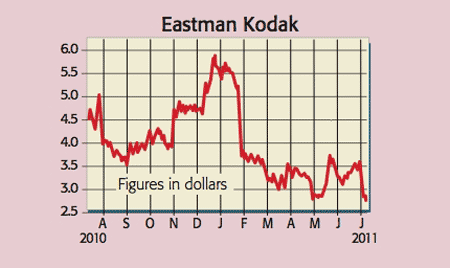1. Sainsbury (LSE: SBRY), rated a BUY by Matrix
If you're an investor in commercial property, then you probably already own shares in British Land and Land Securities. The trouble is that these two real-estate investment trusts already trade at a slight premium to their net tangible assets (NTA).
But there is a cheaper alternative. Sainsbury, Britain's third-largest grocer with a 16.3% market share, owns freehold land and buildings worth about £10.5bn. These assets are only valued in the accounts at £8.8bn. This is important, because factoring in the extra £1.7bn generates an NTA figure of 360p an 8% uplift on the share price. So why is the stock in the dog-house?
MoneyWeek
Subscribe to MoneyWeek today and get your first six magazine issues absolutely FREE

Sign up to Money Morning
Don't miss the latest investment and personal finances news, market analysis, plus money-saving tips with our free twice-daily newsletter
Don't miss the latest investment and personal finances news, market analysis, plus money-saving tips with our free twice-daily newsletter

It appears the bears haven't fully appreciated the value of these assets, and instead honed in on the negatives. Wages are rising at only half the pace of inflation, petrol prices are at a record high and utilities bills are rising. This means less money in people's pockets. Worse, consumers are worried about their jobs. This means they're spending less at supermarkets. Sainsbury's chief executive Justin King commented at the first-quarter results in June that the "pressure on families was the greatest for almost three decades... and we see this persisting for the rest of the year".
The City's other concerns relate to the discretionary nature of Sainsbury's non-food offerings, current supermarket price wars and Sainsbury's rather low sales density of £20 per square foot per week. The latter compares badly to arch-rival Tesco on nearly £25. This gap might not sound too big, yet it has a huge effect on the bottom line. Indeed, with fixed property costs, this translates into operating margins of 3.5% against Morrisons on 5.4% and Tesco at 7.5%.
But that shortfall spells opportunity. Since joining the group in 2004, King has been driving the top line hard by improving quality, stock availability and value-for-money. In fact, research house Kantar Worldpanel estimates that Sainsbury has outperformed its peers nearly every month for the past two years. The brand is also cleverly positioned against its rivals. When times are hard, Waitrose and M&S shoppers tend to trade down to Sainsbury especially its own-label range, which accounts for 50% of turnover. Conversely, when cash- strapped families splash out, they tend to treat themselves by switching up from hard-line discounters Netto and Aldi. An example was the recent royal wedding, when Sainsbury sold more bottles of bubbly than at any time other than Christmas. Its convenience store and online businesses are also motoring along.
The City is forecasting 2011 turnover and underlying earnings per share (EPS) of £22.4bn and 27.6p respectively. So Sainsbury trades on a skinny p/e ratio of 11.6. I value the group on a ten-times earnings before interest, tax and amortisation (EBITA) multiple, assuming sustainable margins of 4.5%. After deducting £1.8bn in net debt and a £241m pension deficit, I arrive at an intrinsic worth of more than £4 a share.
What's more, Sainsbury offers a 4.3% dividend yield and provides inflation protection via its extensive food interests (75% of sales). The group is also a take-over candidate, perhaps for its largest shareholder, Qatar Holdings, which owns a 26% stake and tabled a preliminary bid of 600p back in 2007.
Matrix has a target price of 377p, and a second-quarter trading update is scheduled for 5 October.
Rating: BUY at 322p
2. Eastman Kodak (NYSE: EK), rated a BUY by Rafferty Capital
Contrarians should be greedy when others are fearful' a saying that's fitting for Eastman Kodak, whose shares have lost 95% of their value since 2000. The group was founded in 1880 and was once the world's biggest player in photographic film. However, it dawdled in trying to make the transition to new technology, getting badly burnt as digital cameras took off.

However, the new board is beefing up its digital credentials (73% of sales) and the firm enjoys strong positions in imaging sensors, scanners, video cameras and photo kiosks. In addition, it has four exciting growth platforms, which together are expanding at 23% per year. These are high-speed commercial inkjet presses, consumer inkjet printers, work-flow software and packaging.
Elsewhere, the company is also drawing increasing revenue from licensing out its vast portfolio of patents to electronics manufacturers such as LG, Motorola, Nokia, Sony and Samsung. The two big fish that have so far escaped paying royalties are Apple (iPhone) and RIM (BlackBerry). But that may change. Kodak is claiming patent infringement and awaiting the outcome of a final court case later in the year. The central issue is how images are previewed on mobile phones. The board says that it remains "extremely confident" that the case will ultimately conclude in Kodak's favour. If it's right, then it could trigger a $1bn windfall. That's more than the organisation's entire market capitalisation of $790m.
So what is the whole shebang worth? For 2011, Wall Street is forecasting turnover of $6.4bn, but a loss per share of $2.19. So the best approach is sum-of-the-parts. I rate the digital arm on one times sales (or $4.6bn) and add another $1bn for its extensive patent portfolio. Additionally, assuming the film processing unit (27% of sales) is worth nothing and after deducting pension liabilities ($2.7bn), further restructuring costs ($1bn) and net debt of $146m I get a fair value of more than $5 per share.
Naturally, there are plenty of threats to consider. The firm is exposed to currency fluctuations, changing technology, fickle consumer tastes and tough competition. But with a treasure trove of desirable intellectual property, a globally recognised brand and a dirt-cheap valuation, Kodak is a possible target for private equity. Second-quarter results are due out on 29 July. Rafferty Capital has a target price of $9.50 per share.
Rating: BUY at $2.90
Get the latest financial news, insights and expert analysis from our award-winning MoneyWeek team, to help you understand what really matters when it comes to your finances.
Paul gained a degree in electrical engineering and went on to qualify as a chartered management accountant. He has extensive corporate finance and investment experience and is a member of the Securities Institute.
Over the past 16 years Paul has held top-level financial management and M&A roles for blue-chip companies such as O2, GKN and Unilever. He is now director of his own capital investment and consultancy firm, PMH Capital Limited.
Paul is an expert at analysing companies in new, fast-growing markets, and is an extremely shrewd stock-picker.
-
 ‘Why I have ditched my Help to Buy ISA for cash savings and the stock market’
‘Why I have ditched my Help to Buy ISA for cash savings and the stock market’Without the 25% bonus, my Help to Buy ISA is effectively redundant, says MoneyWeek writer Sam Walker.
-
 Is your inheritance tax allowance cut if you sell to downsize or sell your home to pay for care?
Is your inheritance tax allowance cut if you sell to downsize or sell your home to pay for care?Downsizing relief is a little-known benefit that could save your loved ones tens of thousands of pounds in inheritance tax after you’ve died.